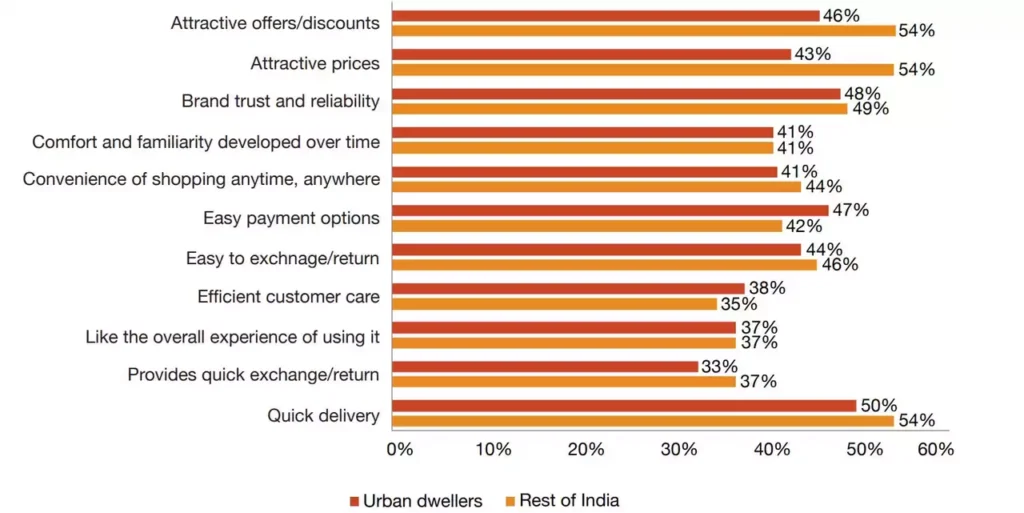While it may appear otherwise, online shopping is no longer confined to metropolitan areas. With increasing digital literacy and widespread internet access, smaller cities and towns are also embracing this trend. Consequently, there are notable differences emerging in the purchasing behaviors, preferences, and attitudes of online shoppers across the country. According to a recent report by PwC, the online shopping demographic in India is no longer monolithic, necessitating distinct strategies for businesses catering to shoppers in major urban centers versus those in smaller locales.
The report titled “How India shops online: Consumer preferences in the metropolises and tier 1-4 cities” divides online shoppers into two distinct categories: those residing in metros and those in the rest of India. It delineates the key differences in preferences of online shoppers in these two geographies, underscoring the importance for digital sellers to take heed, as neglecting these disparities could pose a significant risk. With the continuous growth of e-commerce in India, these variations are expected to solidify further.
Continue Exploring: E-commerce firms boost efforts for gender diversity in supply chain roles
Location can significantly influence buyer preferences, leading to varying consumer behaviors. For instance, online shoppers in bustling metropolises, accustomed to frequent traffic congestion and long commuting distances, prioritize different factors compared to their counterparts in smaller towns, where distances are typically shorter.
City residents, placing a high value on efficiency in online shopping, gravitate towards swift delivery services that cater to their desire for immediate satisfaction, often willing to pay extra for such convenience.

However, shoppers in other parts of India prioritize discounts and deals. These consumers are avid bargain hunters, as they reside in smaller cities where the speed of delivery holds less significance owing to shorter distances.
It’s noteworthy that the majority of purchases in the sports and fitness, home and kitchen, and health and wellness categories are being driven by consumers outside of the major metropolitan areas in India. Meanwhile, residents in metropolitan areas tend to concentrate their spending on grocery items, electronics, and fashion.
The surge of social media has been instrumental in boosting awareness of these products, subsequently driving up demand. In response, platforms have introduced new and budget-friendly products to cater to these cities. As incomes in other parts of India have risen, spending on these categories has also increased accordingly.
Both residents of metro cities and those in other parts of India demonstrate similar levels of acceptance towards UPI payments, suggesting a growing adoption and familiarity with this payment method.
Nonetheless, ‘cash on delivery’ continues to be the favored choice among shoppers in other regions of India as it helps mitigate the risk of fraud. This indicates that while there is an increasing acceptance of UPI payments owing to their convenience, speed, and security, there are lingering apprehensions surrounding online platforms and payment methods, particularly among shoppers outside metro areas.
Continue Exploring: Cash-on-Delivery remains top choice for Indian online shoppers, IIM-A survey finds
Generation X from regions outside of major cities in India typically favors card transactions for mid to high-value purchases on well-known platforms. This preference arises from the direct connection to bank accounts, providing a trusted layer of transaction safety. In urban areas, Paytm is popular for its user-friendly wallet, while in other parts of India, PhonePe is preferred for its intuitive interface. Google Pay ranks second nationwide.
Both categories of shoppers, regardless of their geographic location, exhibit a preference for shopping via apps rather than websites. This preference is consistent among all respondents. The reasons for this inclination include ease of navigation, a simplified user interface adhering to global standards, and support for vernacular languages.
Marketplace apps tend to garner higher download rates due to their diverse range of categories. When it comes to customer service and assistance, consumers generally prefer human interaction over engaging with chatbots.
Despite the geographical differences, marketplaces maintain a dominant position in the consumer market, especially with their combination of fashion and accessories offerings. In urban markets, Amazon holds a slight edge over Myntra, while Flipkart leads the way in the rest of India, followed by Meesho, Amazon, and Myntra. This preference for marketplace apps over category-based platforms is consistent among respondents from the rest of India, underscoring the significance of factors like deals, discounts, accessibility, user-friendly interfaces, and platform familiarity.
Designing experiences that resonate with all users across the country may not be the best way forward for digital sellers. The e-commerce experience that has worked in the urban centres may not necessarily work for the rest of India. The latter will need a more in-depth, human-centric view that acknowledges and capitalizes on the diversity that exists across in these smaller towns and cities.
“The report emphasises the need for tailored e-commerce experiences to resonate with diverse users across India,” says Prateek Sinha, Partner and Leader – Design and Experience Consulting, PwC India. “A human-centred approach, coupled with localised strategies and inclusivity, is crucial for success. It’s about connecting with each customer on a personal level, celebrating the rich tapestry of our cultures, and innovating every step of the way. By embracing agility and a deep understanding of consumer dynamics, businesses can chart a trajectory of sustained growth and profitability. When businesses get this right, they’re not just selling products; they’re creating experiences that people love and trust.”
Continue Exploring: Flipkart revives same-day delivery service across 20 cities, taking on Amazon’s Prime model